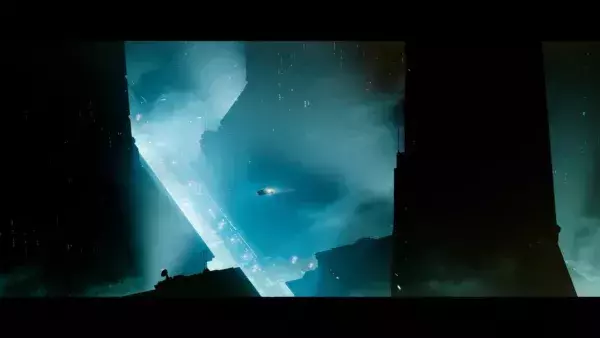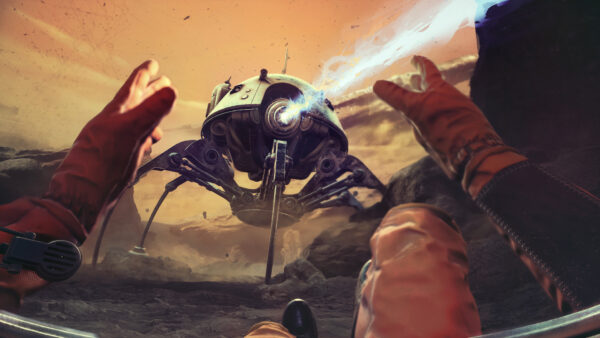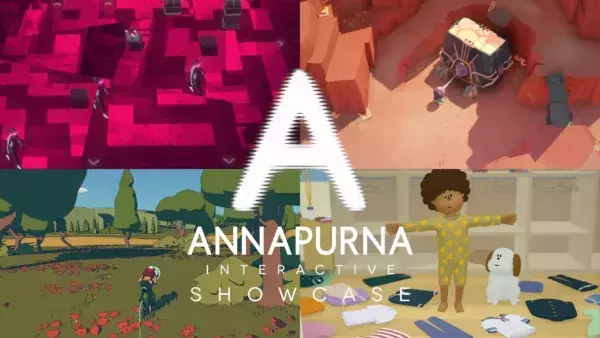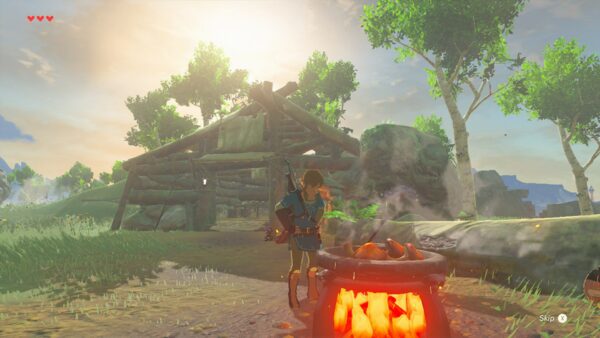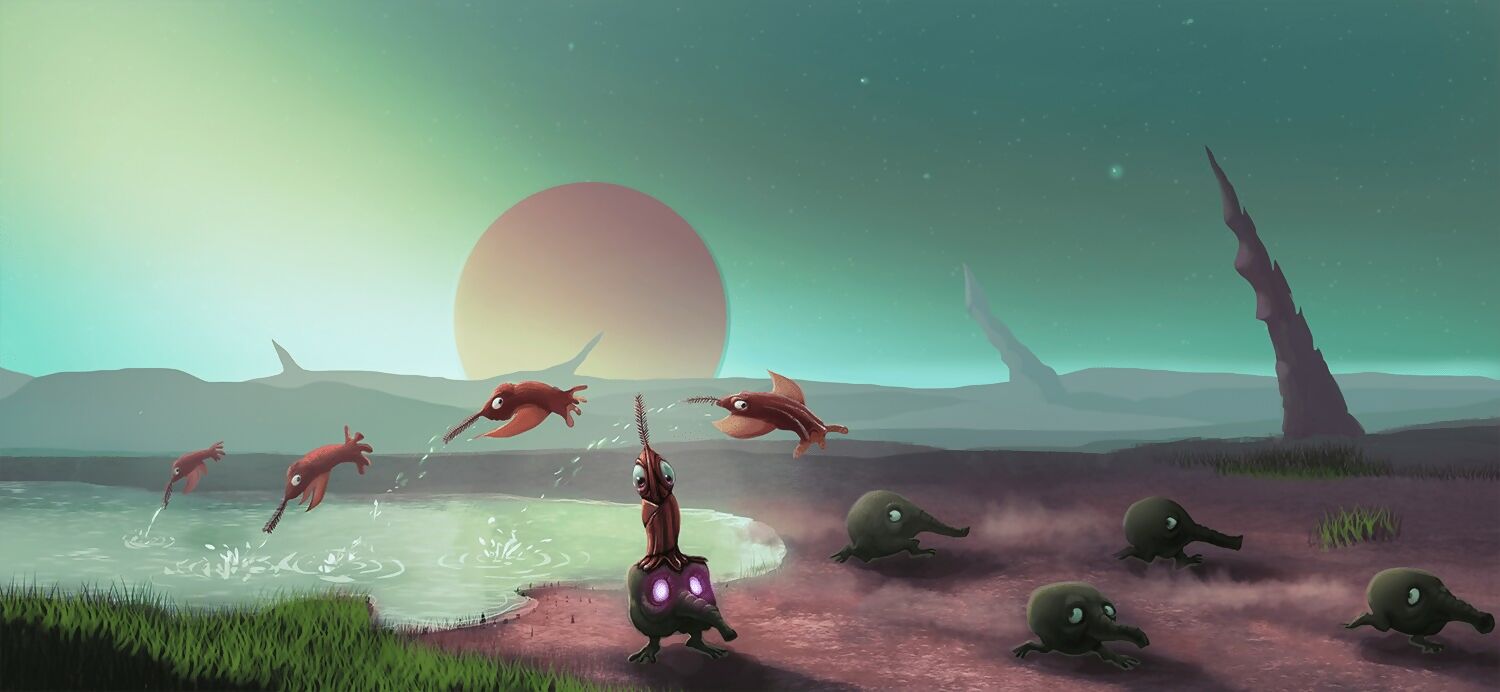
No rubber foreheads. That was one of the stipulations the designers of The Fermi Paradox had in place when designing its space strategy sim – an epic game about guiding civilisations through the ages, from the Neolithic era to interstellar empires. Trying to define what works, and what makes for a successful alien design is a challenge, but one thing its artists were clear on from the start is what they wanted to avoid. “We try to avoid the ‘rubber-forehead aliens’ of Star Trek,” says Jörg Reisig, the creative lead at The Fermi Paradox’s studio, Anomaly Games. “And even when we add humanoid aliens or aliens inspired by normal animals, we like to add enough spins on them so they feel like they could have really evolved on a completely different planet.”
It makes sense. Video games aren’t restricted by the same budgetary and practical constraints of TV and movie aliens, and if you’re designing aliens, you might as well aim for something truly weird. But what’s surprising is how often the process of creating alien life is accompanied by a degree of scientific rigour.
THE APPLIANCE OF SCIENCE
Perhaps the poster child for this is the alien planet survival sim Subnautica, and its even more ambitious Arctic sequel Subnautica: Below Zero. The latter’s creatures were designed by artist Alex Ries, also known for his artwork covering the richly detailed “Birrin” alien world, which he’s currently writing a book about. “Real science is a critical underpinning of my work,” Ries explains. “Because Subnautica has looser rules but explores real scientific concepts, knowledge of phenomena like brinicles, how animals use bioluminescence, and the diversity of extinct sea-life are all foundational. I learned about these things through collecting texts on invertebrate biology, animal guides, and books about important evolutionary events like the Cambrian explosion.”
While The Fermi Paradox doesn’t focus on the science behind its aliens to the same degree, it still informs its designs. “We want to design realistic creatures whose bodies make sense but don’t go that deep into real-life science,” Reisig says. “The player has to know from the picture and a short description how the alien works, and details are left for the imagination – or later follow-up events in the game.”
The process begins with picking one or two main characteristics, such as whether the alien’s an apex predator, or does it produce light in the deep sea, but the primary focus of The Fermi Paradox is social, not biological. “Since our civilisations develop from the stone age to futuristic eras, we can give them a bit more character when they change outfits according to the current technology level,” Reisig says.

Subnautica’s penguins have an innovative beak design, that blinds the creature when it opens.
At the other end of the spectrum there’s The Eternal Cylinder, a game where the player starts out as a lone, vulnerable bottom-feeder forced to evolve when the titular cylinder begins rolling across, and crushing, their entire habitat. The creatures in The Eternal Cylinder look less like they’re out of a zoologist’s notebook and more like something that stumbled out of a Hieronymus Bosch painting, but they are still underpinned by their own internal logic.
“We first came up with the designs and then sat down with the writer to give them a more scientific and logical standing in the alien world we created,” explains Carlos Bordeu, The Eternal Cylinder’s game director. “That was obviously a big challenge as some of the designs were pretty wild. But since our aliens were animals and not ‘monsters’, it was important that they felt as such and didn’t do anything that felt too unbelievable. Only the more surreal or intelligent life forms in the games – those who could have developed technology – have ‘powers’ that would seem like they’re too far-fetched for animals. But obviously, this is a very surreal title, so there are things that are done for the convenience of story and game design.”
ENVIORNMENTAL CONCERNS
One thing all these games have in common is that their alien creatures are shaped by the forces of evolution, which means their design has to take into account not just what a creature’s like, but also its environment.
“Before I start designing anything, we usually first establish what kind of planet these aliens come from,” says Anna Grinenko, the character artist on The Fermi Paradox. “Is it an ice planet, a desert planet, a garden planet? This obviously already determines certain themes, whether or not the creature will move around in water for example, if they can fly and so on.”
Ries also starts from a place of considering the environment of his creatures. “First, the alien must fit the world and aesthetic sensibilities of the universe it is intended for,” he says. “I always keep a few images from the current project to be sure my style is staying true to the rest of that world. After that, I try to be sure the creature makes sense evolutionarily in its setting, showing links and hints of possible ancestry in its design.”

The Vent Garden in Subnautica: Below Zero anchors itself over hydrothermal vents to feed on the nutrients that spew out of them.
SPECULATIVE EVOLUTION
Not that this approach to designing alien life is exactly new. Some of the strangest alien designs you’ll ever see come not from any movie or TV show, but from fictional travelogues and textbooks such as Wayne Barlowe’s beautiful Expedition, or Dougal Dixon’s nightmarish Man After Man. These books form part of a tradition called ‘speculative evolution’, and the most recent example of it was Netflix’s mock-nature documentary, Alien Worlds.
Professor Lewis Dartnell is an astrobiologist who specialises in the search for microbial life on Mars. He’s the author of Life in the Universe: A Beginner’s Guide, and consulted for Alien Worlds. Dartnell explains that speculative evolution is a hugely creative endeavour, but informed by real science. “There’s obviously a huge amount of imagination and creativity that goes into it,” Dartnell says. “But in speculative evolution – and there’s a huge community that does this – it’s about bounded imagination and creativity, working in particular rulesets and principles. You only include things that are physically possible and make good engineering sense. So, in Alien Worlds, they went to great lengths to create things that looked a bit wacky but had a logical sense to them and were plausible.”
It’s easy to see the influence of the speculative evolution genre on Subnautica: Below Zero. “My work simply wouldn’t exist at all without these foundational works,” Ries says. “Barlowe’s Expedition, Dixon’s Man After Man, and Terryl Whitlatch’s The Wildlife of Star Wars showed the way forward for me. They demonstrated that you could take a rigorous natural history approach and apply it to alien life, rather than just creating standalone abstract creatures devoid of evolutionary context.”
LIFE ON THE DRAWING BOARD
Of course, these aliens aren’t actually the result of natural selection. They’re the result of artists’ and designers’ hard work. The process of designing a new alien life form varies from person to person; sometimes they’ll draw from real-world inspirations, or sometimes create a new shape entirely from scratch. “Sometimes the team already has ideas in mind that I can take into account during the design process, sometimes I go on a research spree to find more ideas and inspirations – it really depends on the individual creature,” Grinenko says.

The Fermi Paradox’s Maru species was originally designed with many eyes, before their designers decided to give them no eyes at all.
“On a project like Below Zero, I start simple, with a blank Photoshop canvas,” Ries tells us. “I would sketch out forms to explore possibilities. I don’t bother with shading or colour at this stage, only form. If there’s a specific brief, then I work from references of real-world creatures with similar niches on Earth that the alien might inhabit. If the task is freeform I’ll draw on my knowledge of ecology and zoology to put together creatures that are visually and behaviourally interesting, while remaining functional within the rules of the Subnautica universe.”
In games, it’s often crucial that players can identify a creature quickly and easily, sometimes from a distance, so ‘silhouette’ is a word that often comes up in conversations about alien design. “You want to focus on the silhouette a lot, make sure it stands out from other creatures in the game,” Bordeu says.
“The silhouette of an alien is very important,” Grinenko agrees. “I want the designs to look different from each other in the game, preferably instantly recognisable, so I didn’t want to limit myself with poses, or make everybody humanoid because of that. That does bring more workload, though. It’s practically impossible to recycle something from one alien to another – the more animalistic or surreal the alien, the longer I spend in the sketch phase and the more difficult the clothes, and you need to get very creative with how they adapt through their eras.”
ALIEN LOGIC
Once the shape’s established, it’s time to start thinking about the implications of that shape, both how it informs the alien’s behaviour, and how its behaviour is informed by its environment.
“One of our community favourites – the Maru – actually started out as a many-eyed raptor,” Grinenko says. “While sketching, I suddenly thought, ‘Wouldn’t it be wicked if they actually had no eyes at all?’ Suddenly, it got really exciting to think about how they’d perceive things – is it smell, echo location, hearing? So, just with that small change, a lot of very cool concepts popped up that initially didn’t even seem that interesting.”

On alien worlds, the binary between plant and animal may be different, with sentient plants, or creatures like this land-based coral from The Eternal Cylinder.
It’s common for the design process to throw up ideas that are eliminated along the way. Natural selection has a similar process: if a particular creature design doesn’t work, it dies and leaves no offspring. This means designers need to try and avoid design flaws that would get their creatures ‘deselected’.
“You expect a logic behind the design of the animals and also obvious flaws that would have been avoided,” Dartnell says.
Dartnell points to one of the more interesting designs in Subnautica: Below Zero – its alien penguins. “There’s a nice idea here,” he says. “All vertebrates on Earth have a mouth that moves up and down – this penguin has a mouth that opens side-to-side. But what wouldn’t work so much is it seems this alien penguin, as soon as it opens its mouth, it blinds itself to the thing it’s trying to catch.”
Of course, that’s not to say evolution doesn’t make mistakes either. “There’s a litany of errors in the human body,” Dartnell points out. “For instance, we can choke because our swallow and breathing hole are in the same place. But you won’t survive long with a critical design flaw.”
THE GAME ENVIORNMENT
As well as being adapted to a game’s fictional world, creature designs must also be adapted to the digital environment they need to navigate. “A good example is the Tonglegrop – a giant predator that is one of the larger enemies that hunts the player in [The Eternal Cylinder],” says Bordeu. “Since we knew the terrain of the game was going to be uneven – an issue that is usually problematic in game development – having a creature that moved by walking on top of a boulder-shaped bottom was a convenient way of making it easier to implement, since it pivots from a single spot under it rather than multiple points like a quadruped. The projectile vomit was also an easier attack to implement, as this allowed the creature to be very good at attacking foes all around it.”
Ries also points to ways that the technical limitations of a video game can inform the design of a creature. “In games, technical limitations are quite important, particularly with size,” he says. “A giant creature in the shallows will have terrain clipping issues, for instance. You have to make sure it looks interesting from the front because that’s the attack direction.”
This is more of a concern when there’s a fully realised 3D simulation for a creature to exist in. Without those considerations, designers have more options.
Says Reisig: “Since we don’t have constraints that many other sci-fi games have, like aliens having to fit into generic outfits or needing to be able to carry and use generic weapons, we try to embrace this freedom and give them unique and strange body shapes and extremities.”
EXTRA-TERRESTRIAL INTELLIGENCE
Most of the examples we’ve looked at here have been animals, without language, tool use, or any of the other things we typically call ‘intelligence’. Once you start designing an intelligent species, the demands get far more complicated. “The point about intelligence is there’s probably only a limited set of conditions to which intelligence is the right answer,” Dartnell says. “Humans evolved in a chaotic, unstable climate in the Rift Valley of East Africa. And intelligence is also expensive. To have a large brain you need to provide a huge amount of energy to that brain.”

Even The Eternal Cylinder’s more outlandish designs – like this giraffe – are inspired by things in nature.
To design an intelligent alien on another planet, Dartnell argues you’d need similar circumstances. There needs to be a reason why this species developed intelligence rather than a simpler solution, such as running faster. Once it has that intelligence, it then has the challenge of feeding it. “It’s probably not purely herbivorous,” Dartnell says. “Which is why cows spend their entire day chewing and don’t have time to invent tools.”
NOT AS WE KNOW IT
Dartnell also cautions against designing aliens that look too familiar, however. “A general principle is that aliens often aren’t alien enough, and are simply mixes of Earth animal components, or they’ve been made a different colour,” he says. “It’s not often you’re truly surprised by how an alien looks. It could go a bit wilder.”
This is a goal shared across the board among the game designers and artists we talked to. “I think it’s also important to use references and find inspiration, but to not get too restrained by it, either,” Grinenko tells us. “You want this alien to have nine legs? Sure, it has nine legs now! This isn’t Earth. We don’t need to apply things from our world one-to-one on something else, and there can be thousands of reasons why that is. Maybe it doesn’t make sense for horses on our planet to not have eyes, but maybe a horse-like creature on another planet has no problems with that, because it simply functions differently.”
Bordeu also points to aliens looking far too terrestrial as a common flaw in some games. “I do feel we made that mistake with a couple of creatures in [The Eternal Cylinder], that they look too ‘earthly’,” he admits. “But we just had to do so many creatures that it was hard being totally original with all of them. The biggest mistake I often see is just making creatures that look like normal animals that are ‘stitched’ together.”
Even when taking inspiration from Earth organisms, Ries points out that many designers are drawing from too small a pool of sources. “I believe the only true mistakes one can make in art are to create in a way that makes you unhappy, or that hurts vulnerable people,” he says. “However, more broadly, I believe we – including myself – rely too much on vertebrates as reference points. Creature design is dominated by aliens developed from beings related to us, perhaps with a few invertebrate touches thrown in. Partly this is because the only large land animals we have as reference are vertebrates.”
He suggests that artists can break this habit by looking to Earth’s pre-history for inspiration. “I encourage people to look into what life was like millions of years ago in the coal forests of the Carboniferous [period], with its six-foot-long millipedes, or the oceans of the Ordovician [period],” he says.

As well as designing each species, The Fermi Paradox also mapped out how they evolved.
Even when drawing from fictional sources, there’s a danger of seeming too familiar. “If you’re not actively aiming for it, I would always try to avoid copying an established alien trope, especially visually,” Reisig says. “The player may get instantly familiar with the creature, but often it lacks originality, which makes the overall world-building of the game a bit boring. Also, I would be careful and deliberate with anthropomorphisms.”
Dartnell points to Subnautica: Below Zero as an example of alien design done right. “The squid shark swims with jet propulsion – no vertebrate animal on Earth does, but there’s no physical reason it couldn’t,” he says.
Of course, a huge difference between real science and science fiction is that in the latter, there’s nothing wrong with leaving something to the audience’s imagination. “I’ve learnt that sometimes less is more,” Grinenko says. “You don’t actually need to show everything because players are creative and clever. I do have ideas about how the aliens move around and do things, but I’ve also read really interesting interpretations in our community that could work just as well.”
Perhaps the most important thing to bear in mind is that to these extra-terrestrials, we are the aliens. “The Half-Life series gave us some of the most amazing and truly alien designs as well,” Ries says, “made even more interesting because many of the creatures were simply animals dropped unwillingly into our world, trying to survive as best they could. Not monsters, just beings like us.” As Grinenko points out: “The key, I think, is to think about them as protagonists, as opposed to nameless background characters.”
This is an edited version of a feature originally published in Wireframe #59. You can get a copy here.


